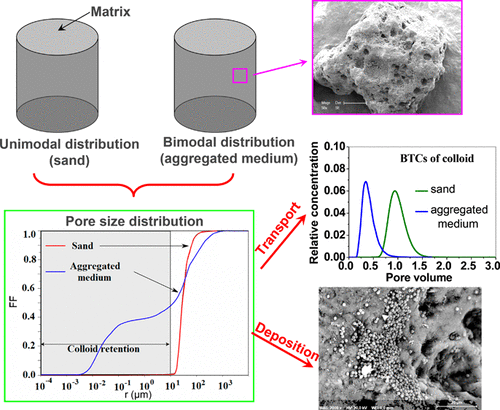当前位置:
X-MOL 学术
›
Ind. Eng. Chem. Res.
›
论文详情
Our official English website, www.x-mol.net, welcomes your
feedback! (Note: you will need to create a separate account there.)
Colloid Transport in Aggregated Porous Media with Intra- and Interaggregate Porosities
Industrial & Engineering Chemistry Research ( IF 3.8 ) Pub Date : 2018-04-23 , DOI: 10.1021/acs.iecr.8b00501 H.J. Bai 1, 2 , L. Lassabatere 3 , E. Lamy 1
Industrial & Engineering Chemistry Research ( IF 3.8 ) Pub Date : 2018-04-23 , DOI: 10.1021/acs.iecr.8b00501 H.J. Bai 1, 2 , L. Lassabatere 3 , E. Lamy 1
Affiliation

|
Column tracer and colloid transport experiments were performed under both saturated and unsaturated steady state flow conditions in an aggregated porous medium with a bimodal pore size distribution (PSD): intra-aggregate porosity with a pore radius between 10–2 and 10–1 μm and interaggregate porosity ranged between 101 and 103 μm (interporosity). All experiments were carried out under unfavorable conditions for physicochemical attachment to solid–water interfaces, using negatively charged porous media and latex microspheres (1 μm). Both porous media and colloids used in this work were hydrophobic. The results obtained through experimental observations and numerical simulations in the aggregated medium were confronted with those obtained for a sandy medium, characterized by a narrow unimodal PSD with a pore radius which ranged between 101 and 102 μm (interporosity), to explore the relative importance of the PSD on water flow, colloid transport, and deposition. Physicochemical interactions between colloids and porous media, calculated according to the Derjaguin–Landau–Verwey–Overbeek (DLVO) theory, showed no primary minimum and low secondary minimum depth, suggesting reversible colloid retention and possibility for colloid detachment by hydrodynamics drag for both sand and aggregated media. Hydrodynamic drag forces were slightly greater than the resisting adhesive DLVO forces in the secondary minimum, indicating a possibility for colloid detachment. For the same flow rate, more nonuniform transport of colloids were obtained in the bimodal aggregated medium compared to the unimodal sand. If the nonuniform and preferential transport of colloids should contribute in decreasing of colloids retention, particularly under saturated flow conditions, surprisingly greater overall colloid retention was obtained in the aggregated medium. Based on the PSD, colloid exclusion from smaller pores has a higher probability to occur in the aggregated medium compared to the sand. Therefore, size exclusion contributed to the overall preferential transport in this dual porosity medium, and it was expected that this nonuniform transport would disfavor colloid retention. However, colloid retention efficiency at the column scale was higher for the aggregated medium compared to the sand under saturated flow conditions, despite a more uniform flow and transport in the later. This means that the presence of the intraporosity in the aggregated medium and related small pores contributed not only in colloid size exclusion, but it had also an opposite effect, resulting in additional deposition sites of colloid particles. Under unsaturated flow conditions, capillary forces governed colloid retention, independently from the PSD.
中文翻译:

具有内部和内部聚集孔隙的聚集多孔介质中的胶体运输
在具有双峰孔径分布(PSD)的聚集多孔介质中,在饱和和不饱和稳态流动条件下均进行了示踪剂和胶体迁移实验:聚集体内部孔隙度为10 –2到10 –1μm,并且骨料间孔隙度在10 1和10 3之间μm(孔隙度)。所有实验均在不利条件下进行,使用带负电的多孔介质和乳胶微球(1μm)将化学化学方法固定在固-水界面上。在这项工作中使用的多孔介质和胶体都是疏水的。在聚集介质中通过实验观察和数值模拟获得的结果与在砂质介质中获得的结果相对,其特征是具有窄的单峰PSD,孔径范围在10 1和10 2之间。μm(孔隙度),以探讨PSD对水流,胶体运输和沉积的相对重要性。根据Derjaguin–Landau–Verwey–Overbeek(DLVO)理论计算,胶体与多孔介质之间的物理化学相互作用没有显示出最小的初生深度和较低的次生最小深度,这表明砂土和砂岩的流体动力学阻力可逆的胶体保留和胶体分离的可能性。汇总媒体。在次要最小值中,流体动力阻力略大于抵抗粘合剂的DLVO力,这表明胶体可能脱落。对于相同的流速,与单峰砂相比,在双峰聚集介质中获得了更多的胶体非均匀运输。如果胶体的不均匀和优先运输会导致胶体保留降低,特别是在饱和流动条件下,则在聚集的介质中获得了令人惊讶的更大的总体胶体保留。基于PSD,与沙子相比,从聚集的介质中排除小孔胶体的可能性更高。因此,尺寸排阻促进了该双重孔隙介质中总体优先运输,并且预期这种不均匀运输将不利于胶体保留。但是,在饱和流动条件下,与沙子相比,聚集介质的柱状胶体保留效率更高,尽管后者的流动和传输更为均匀。这意味着聚集介质和相关小孔中孔隙的存在不仅有助于胶体尺寸的排阻,而且具有相反的作用,导致胶体颗粒的沉积位置增加。在不饱和流动条件下,毛细作用力独立于PSD支配着胶体的保留。
更新日期:2018-04-24
中文翻译:

具有内部和内部聚集孔隙的聚集多孔介质中的胶体运输
在具有双峰孔径分布(PSD)的聚集多孔介质中,在饱和和不饱和稳态流动条件下均进行了示踪剂和胶体迁移实验:聚集体内部孔隙度为10 –2到10 –1μm,并且骨料间孔隙度在10 1和10 3之间μm(孔隙度)。所有实验均在不利条件下进行,使用带负电的多孔介质和乳胶微球(1μm)将化学化学方法固定在固-水界面上。在这项工作中使用的多孔介质和胶体都是疏水的。在聚集介质中通过实验观察和数值模拟获得的结果与在砂质介质中获得的结果相对,其特征是具有窄的单峰PSD,孔径范围在10 1和10 2之间。μm(孔隙度),以探讨PSD对水流,胶体运输和沉积的相对重要性。根据Derjaguin–Landau–Verwey–Overbeek(DLVO)理论计算,胶体与多孔介质之间的物理化学相互作用没有显示出最小的初生深度和较低的次生最小深度,这表明砂土和砂岩的流体动力学阻力可逆的胶体保留和胶体分离的可能性。汇总媒体。在次要最小值中,流体动力阻力略大于抵抗粘合剂的DLVO力,这表明胶体可能脱落。对于相同的流速,与单峰砂相比,在双峰聚集介质中获得了更多的胶体非均匀运输。如果胶体的不均匀和优先运输会导致胶体保留降低,特别是在饱和流动条件下,则在聚集的介质中获得了令人惊讶的更大的总体胶体保留。基于PSD,与沙子相比,从聚集的介质中排除小孔胶体的可能性更高。因此,尺寸排阻促进了该双重孔隙介质中总体优先运输,并且预期这种不均匀运输将不利于胶体保留。但是,在饱和流动条件下,与沙子相比,聚集介质的柱状胶体保留效率更高,尽管后者的流动和传输更为均匀。这意味着聚集介质和相关小孔中孔隙的存在不仅有助于胶体尺寸的排阻,而且具有相反的作用,导致胶体颗粒的沉积位置增加。在不饱和流动条件下,毛细作用力独立于PSD支配着胶体的保留。









































 京公网安备 11010802027423号
京公网安备 11010802027423号